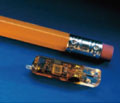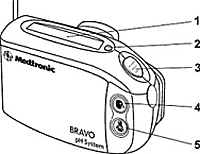Procedures
Click below for more detailed information:

The small bowel capsule study is a video technique for examining the small intestine. This is an area of the digestive tract not well seen by conventional endoscopic techniques. Pill capsule endoscopy involves swallowing a small “pill camera” which records photographs on a pager-like device the patient wears during the examination. The pill passes out of the digestive tract with the stool and is not recovered. The images are downloaded and interpreted after return of the recorder. This technique is not a substitute for endoscopy or colonoscopy, but is a very useful complementary tool to traditional examinations of the bowel.
Wireless Capsule Endoscopy is a state-of-the-art technique to record images of the digestive tract not usually visualizable by conventional endoscopy. The capsule is the size and shape of a vitamin pill and contains a tiny camera. After a patient swallows the capsule, it takes pictures of the inside of the gastrointestinal tract. The primary use of capsule endoscopy is to examine areas of the small intestine that cannot be seen by other types of endoscopy such as colonoscopy or esophagogastroduodenoscopy (EGD). This type of examination is often done to find sources of bleeding, malabsorption, weight loss, or abdominal pain. The procedure was approved by the U.S. Food and Drug Administration (FDA) in 2001. Capsule endoscopy is used to examine parts of the gastrointestinal tract that cannot be seen with other types of conventional endoscopy. Upper endoscopy, also called EGD, uses a camera attached to a long flexible tube to view the esophagus, the stomach and the beginning of the first part of the small intestine (called the duodenum). A colonoscope, inserted through the rectum, can view the colon and the distal portion of the small intestine, and the very end of the small intesine (the terminal ileum). Unfortunately, these two types of endoscopy cannot visualize the majority of the middle portion of the gastrointestinal tract, the small intestine. The small intestine can measure 15 feet in length. Endoscopy of this entire length is technically difficult but capsule endoscopy can approach the area conveniently and safely. Capsule endoscopy is useful when disease is suspected in the small intestine and can diagnose sources of occult bleeding, iron deficiency, malabsorption, diarrhea, or causes of abdominal pain such as Crohn’s disease. Capsule endoscopy can be used to diagnose problems in the small intestine, but unlike EGD or colonoscopy, cannot treat pathology that may be discovered. It can, however, guide management such as drug therapy or surgery.

Hydrogen breath tests are very helpful in the diagnosis of common gastrointestinal disorders. We use them to determine if patients are having trouble digesting substances like lactose and fructose (certain common sugars). These disorders often cause gas, bloating, abdominal pain and diarrhea. Disorders of digestion of these entities can often mimic other disease, and are actually quite common.
These tests are simple to do. The patient fasts after midnight the night before and then drinks either milk (for the lactose test) or soda (for the fructose test) a few hours before they come to the office. Once at our office, a breath sample is easily collected and analyzed. Results are available immediately and recommendations can be given promptly.
A baseline test can also be performed, to screen for general malabsorptive conditions or bacterial overgrowth. No special preparation, fasting, or ingestion of a drink as described above is needed for the baseline screening test.

Intraesophageal pH testing allows your physician to determine if and how much acid reflux is present. It may diagnose reflux in atypical cases, such as when only throat symptoms are present. It may also help to determine whether your medication is working optimally for you.
What is the Bravo™ pH Monitoring System?
The Bravo™ pH Monitoring System is a catheter-free way to measure pH.

The Bravo system involves a pH capsule, about the size of a gel cap, that is temporarily attached to the wall of the esophagus. The Bravo™ pH Capsule measures pH levels in the esophagus and transmits readings via radio telemetry to the Bravo™ Receiver worn on the patient’s belt or waistband. The patient also records symptoms he or she experiences in a diary by pressing buttons on the receiver. The Bravo pH capsule collects pH measurements for up to 48 hours. After the study, data from the receiver is uploaded to a computer and diary information is entered for analysis to aid in the diagnosis and plan treatment. Normal patient activities such as swallowing, eating and drinking should cause the disposable pH capsule to detach and pass through the digestive tract in 5-7 days on average.
How is the Bravo pH capsule attached to the esophagus?

The doctor uses the Bravo™ Delivery System to insert the pH capsule through the mouth or nose and position it above the lower esophageal sphincter. Once the pH capsule is in place, suction is applied, drawing a small amount of esophageal tissue into the capsule and locking it in place. The delivery system is then withdrawn and the pH capsule can begin measuring pH levels.
What are the benefits of the Bravo pH monitoring system?
The Bravo system is more comfortable than traditional pH testing methods. It causes less nasal and throat irritation than the trans-nasal catheter. Because it is catheter-free, patients feel more comfortable maintaining their normal diet and activities with the Bravo system, since no one can tell they’re undergoing a pH test.
By allowing patients to maintain their regular diet and activities, the Bravo system yields more representative test results to aid diagnosis and plan treatment.
Are there clinical studies showing that the Bravo system is more acceptable to patients than traditional catheter-based testing methods?
Yes. In a study1 by Ronnie Fass, M.D. et al., the Bravo system was compared with catheter-based pH monitoring to evaluate satisfaction, discomfort and ability to carry out activities of daily living.
The study showed that pH monitoring with the Bravo system causes “significantly less nose pain, running nose, throat pain, throat discomfort as compared with the traditional pH probe.” The Bravo pH monitoring system was perceived as less interfering in overall daily activities, including sleep patterns, than the catheter based system.
Patients in the group that used the Bravo system were significantly less bothered by the test and rated their overall satisfaction with the test as better than that of the patients in the catheter group. More patients in the Bravo group said they would be willing to repeat the test.
Another study2 found that these improvements over the traditional method allow pH monitoring with the Bravo system to occur within the context of the patient’s normal daily experience without modification of diet or activity level. There were no serious complications with either pH testing method in this study.
References
1. Dekel R, Malagon I, Green C, Fass R. Comparison of transnasaly placed wireless pH capsule (Bravo) versus traditional 24-hour esophageal pH monitoring – a randomized trial. Am J Gastroenterol. 2003 Sept;98(9):Supp 1.
2. Ours T, Richter J. Bravo pH vs ambulatory 24 hour catheter pH monitoring: a prospective assessment of patient satisfaction, discomfort and impairment of daily activities. Digestive Disease Week. San Francisco, CA, May 19-22, 2002, Abstract W1174.
What side effects are possible with the Bravo pH Monitoring System?
Potential complications of the oral insertion method for the Bravo pH capsule are those associated with upper gastrointestinal endoscopy. They include but are not limited to:
» Perforation
» Hemorrhage
» Aspiration
» Fever
» Infection
» Hypertension
» Respiratory arrest
» Cardiac arrhythmia or arrest
Potential complications associated with the Bravo pH Capsule with Delivery System include but are not limited to:
» Premature detachment of the pH Capsule
» Failure of the pH Capsule to detach from the esophagus within several days after placement
» Discomfort associated with the pH Capsule requiring endoscopic removal.
How to Operate the Receiver
The Bravo pH Receiver is an ambulatory data recorder for monitoring gastroesophageal pH. The device stores data from Bravo pH capsules for periods up to 48 hours. Once the pH study is completed, you return the receiver to your physician, so he or she can upload the data and diagnose your condition.

1. Display: displays current time and optional pH readings.
2. Indicator Light: illuminates for 3 seconds, when the symptom button is pressed.
3. Heartburn Button: press this button, when experiencing heartburn.
4. Regurgitation Button: press this button, when experiencing regurgitation.
5. Chest Pain Button: press when experiencing chest pain.
Using the Receiver
The Receiver provides three symptom buttons. You simply press the correct buttons anytime during a pH study, when you experience Heartburn, Regurgitation, or Chest Pain.
| Heartburn | |
| Regurgitation | |
| Chest pain |
Using the Patient Diary
Patients record meals, and user-defined periods in a paper diary (or in the sample diary found on this website). Use the clock on the Receiver’s display to note start and end times. User-defined periods allow patients to record a period of time, when they are engaged in an activity that they believe may affect the pH readings, such as smoking, exercising, coughing, or wheezing.



